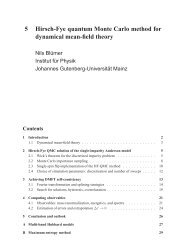Hubbard Model for Asymmetric Ultracold Fermionic ... - KOMET 337
Hubbard Model for Asymmetric Ultracold Fermionic ... - KOMET 337
Hubbard Model for Asymmetric Ultracold Fermionic ... - KOMET 337
You also want an ePaper? Increase the reach of your titles
YUMPU automatically turns print PDFs into web optimized ePapers that Google loves.
48 CHAPTER 5. STRONG COUPLING LIMIT⎛⎜⎝1000⎞⎛⎟⎠ = |1 ↑,1 ↓〉;⎜⎝0100⎞⎛⎟⎠ = |1 ↑,2 ↓〉;The eigenvalues of H can easily be calculated:√E 3/4 = U 2 ±⎜⎝0010⎞⎛⎟⎠ = |2 ↑,1 ↓〉;√2U+ (t ↑ − t ↓ )42 ; E 5/6 = U 2 ±These eigenvalues may now be analyzed at strong coupling.5.1.2 “Band structure” at strong coupling⎜⎝0001⎞⎟⎠ = |2 ↑,2 ↓〉 .(5.4)2U+ (t ↑ + t ↓ )42 . (5.5)In Figures 5.1 and 5.2 we demonstrate the energy levels at strong coupling graphically (parameters:U = ±15; t ↑ = 3; t ↓ = 1.5; half filling):Energy levels a.u.1512.5107.552.50Figure 5.1: E 1−6 atEnergy levels a.u.-2.5-7.5-10-12.5-15Umax{t ≫ 1 σ}0-5Figure 5.2: E 1−6 atUmax{t σ} ≪ −1Obviously the energy levels are close to the values 0 and U. A Taylor expansion ( of E)1−6with respect to the hopping amplitude shows that each level behaves like 0 + O t 2 σUor( )U + O t 2 σU. From now on, at strong coupling, we call levels close to an integer n multipleof U, levels with effective double occupancy n. Note that effective double occupancy differsfrom real double occupancy in the language of the c operators, since real double occupancyis not a good quantum number at t ↑ or t ↓ different from 0 in this language. Levels withn = 0, <strong>for</strong> example, may have 〈n i↑n i↓〉 ≠ 0. In the next section we will per<strong>for</strong>m a unitarytrans<strong>for</strong>mation, which trans<strong>for</strong>ms the c operators into d operators, so that effective doubleoccupancy in the c language is mapped onto real double occupancy in the new d language.5.2 General procedureIn this section we treat the general modelH = U ∑ in i↑n i↓− ∑ ijσt ijσc † iσ c jσ; t ijσ≥ 0 , (5.6)which we rewrite as H(c) = H U (c)+H t (c) in the strong coupling limit (U/max{t ijσ } → ±∞).We per<strong>for</strong>m an unitary trans<strong>for</strong>mationc † iσ = exp[S(d)]d† iσexp[−S(d)] , (5.7)













